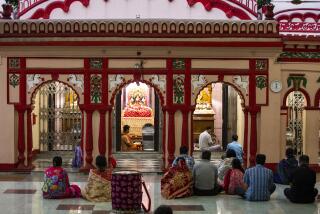Bangladesh’s Landless Poor Go Hungry
- Share via
PALASHTALA, Bangladesh — Zarina Khatoon sold her aluminum cooking pot to buy food for her four hungry children.
“The cooking pot was the last asset I could sell. My children were going without food for two days. They had nothing but water,” Zarina said, wearing a ragged sari and sitting on the ground in front of her mud-and-straw house.
Her plight is common among the families of 65 million landless day laborers in this poverty-stricken nation of 110 million people. When there are no fields to tend, there is no money to earn.
The Jamalpur district, 90 miles north of Dhaka, was ravaged by last summer’s monsoon-spawned floods. Now it suffers from drought. But so far the main problem is not availability of food, relief workers say. It’s the shortage of work.
The sowing season is over. For landless day laborers, there will be no more work until the rice crop now in the ground is harvested in early June--if the paddies survive the drought.
Zarina Khatoon’s husband, Mokbul Ahmad, left home to look for work. Two weeks later, he had not returned to Palashtala, 12 miles south of Jamalpur.
Shortly after he left, Zarina sold her cooking pot for 15 takas, about 46 cents. She promptly spent 31 cents on 2.2 pounds of flour, which saw her family through two meals.
The 25-year-old woman said her situation had improved slightly since she found work digging a pond for 15 takas a day.
“Still, I cannot buy rice for my family,” she said. “Rice is out of my reach.”
Rice is the staple of the Bangladeshi diet. Two weeks ago, low-quality rice sold for 28 cents a pound. The government pumped some reserve stocks into the area, and the price fell a little--to 25 cents a pound.
“It’s not the question of availability of rice. The problem is the poor people have no money to buy food. They have no jobs,” said Fakhrul Ahsan, a local worker for the privately run Bangladesh Rural Development Committee.
He said the committee is working with 56,000 people living in 47 villages in the Jamalpur region, doing post-flood rehabilitation work and trying to provide jobs such as building roads and making handicrafts.
“Almost 30% of the people we cover are living in extreme conditions,” Ahsan said. “They take flour and boil it with water. They can’t make bread from wheat as that fails to feed all the members of the family.
“This is a lean period for agriculture workers. There is no work in the fields until the next harvest comes. The poor, landless people eat on days they can work. On workless days they go without food,” he added.
“We have no report of anyone dying for lack of food, but the situation is pretty bad,” said Debabrata Das, another worker from the Bangladesh Rural Development Committee.
Abdul Hamid, who lives in Narayanpur near Palashtala, said he earned 15 takas a day working for wealthy farmers.
“The money I earn cannot buy rice for me and my family,” the 35-year-old father of three said. “Rice has become a luxury item for us.”
Bangladesh, where the per-capita annual income is $160, needs 18.5 million tons of rice and wheat a year to feed its people. In good years, it produces 17 million tons. It tries to import an additional 2 million tons to cover the shortfall and provide an emergency reserve.
Last year, the floods wiped out 2.5 million tons. The spring rice crop now in the ground was expected to produce about 5.6 million tons, but agriculture officials in Dhaka fear at least half will be lost to the drought.
More to Read
Sign up for Essential California
The most important California stories and recommendations in your inbox every morning.
You may occasionally receive promotional content from the Los Angeles Times.













